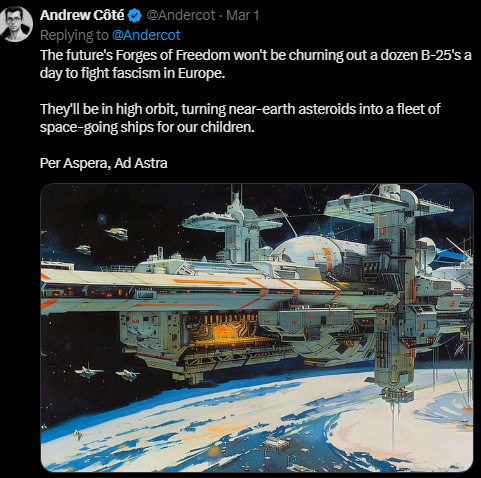Accelerate Effectively
No longer confined to the fringes of social media, there is a new narrative quickly becoming dominant among serious thinkers. It's called e/acc and it is a pro-markets, pro-technology, pro-human narrative. Its ideas have already found their way into literature:
Jordan B. Peterson’s “A Conservative Manifesto”,
Johan Norberg’s “The Capitalist Manifesto”,
Marc Andreessen’s “The Techno-Optimist Manifesto”.
Aaron Slodov's "Techno-Industrialist Manifesto"
James Pethokoukis's “The Conservative Futurist”
At the heart of it is a commitment to lifting all humans out of poverty, while protecting the environment as much as reasonably possible, a vision of material abundance, freedom, and human flourishing. Maybe even off planet.
Recognizing that there is as much raw material as there was 100,000 years ago, adherents believe raw materials are not constraining our options as much as our lack of knowledge about how to use it properly does. Knowing that there is several thousand times as much solar energy hitting the earth as we would need to power all of our demands easily, or knowing that two billion times as much energy is missing the earth entirely, helps us approximately as much as knowing that DT, DD or HB11 fusion works. If we don't know know how to use it commercially, the raw existence of such vast energy flows and stores does not help us. The scientific revolution and industrialization are still at the beginning of generating the necessary knowlege about how to transform raw material and energy into more useful forms, yet they have already reduced human suffering tremenduously.
To realize e/acc's commitment, adherents focus on a series of technologies that have the potential of improving the future at an accelerating rate. Another major component is getting rid of of stifiling overregulation, (or "stealth command&control economy") like NEPA, certain barriers to high-skilled immigrants or laws that allow or even force companies, administrations or individuals to discriminate on anything other than merit.
New frontiers are opening up to realize that vision, presenting opportunities for entrepreneurs:
Robotics need to be applied at scale to far more new industries. Food production, maintenace and manufacturing of industrial equipment, construction work, elderly care, remote control of equipment everywhere, 3D printing with increased precision down to the atomic level, underground and deep-sea mining.
AI needs to be developed and applied to all sorts of administrative, planning, inspection, surveillance, transportation and diagnostic work. Intelligence augmentation via an interface to the human brain might also be in the cards.
Biotech for creating new crops and breeds of animals, ultimately making the latter unnecessary, mRNA vaccines (for example against malaria, cancer, etc.), targeted therapies for rare and chronic diseases, ultimately reversing the effects of age.
Energy will need to be provided carbon-free and cheaply. The field is wide open for advanced nuclear fission and fusion (there is even some serious research into LENR now), bringing down the price of deep geothermal, carbon capture, storage of energy is batteries and bricks, more efficient solar panels.
Transport: cheaper rockets, commercial supersonic flights, electric VTOLs, space planes, better drones - including on streets, rails, rivers and oceans, airships.
Space remains the ultimate frontier. Today, it costs something like $1500 to get 1 kg of material into space. Entrepreneurs have set their eyes on bringing that price down to $10/kg. Mining asteroids and sending virtually unlimited amounts of space-based solar power back to earth - and even visiting space touristically could become possible. If some gigantic piece of new infrastructure, like a space elevator, proved necessary on the way to that price point, e/acc is not daunted.
High-efficiency, highly automated manufacturing will play a key part in opening up the last frontier. Fortuitously, that is also the kind of manufacturing that is necessary for material abundance and military safety.
Hadrian is a good example of how manufacturing will have to look like soon:
The creation of new forms of manufacturing by merging new software, hardware and processes should bring down the cost and time of manufacturing the compoenents necessary for building the energy infrastructure to power more of the automation and AI in a virtuous cycle. Let's look a nuclear as an example of that.
Applying scan-to-CAM reduces the machining times for a nuclear RPV by around 40%, cooling the milling tools with supercritical CO2 extends their life hugely.
Using a electron beam welding reduces the time it takes to weld a RPV from around a year down to a day.
Applying all of these advances slashes the production time for a nuclear RPV from 3 years down to 10 months. In combination with more sensible nuclear regulation, ordering the NRC to weigh costs AND benefits for nuclear fusion and fission, as well as with better business cases for high-temperature nuclear like the recovery of unconventional oil in rather inhospitable and remote areas, for example by using@TerrestrialMSR's IMSRs, the stage looks set for real deployment with a sensible learning curve and target price.
Similarly, advancements of technology (lithium batteries and electric motors in this case) makes new transportation technologies possible. For example, the Adaptive Cycle Jet Engine might make getting to space far cheaper by accelerating the craft in the optimal regime given its height and speed. If that does not given "e/acc" a symbol as fitting as anyone could only hope for, I don't know what would:
The future does look bright, if we commit to making it so.






